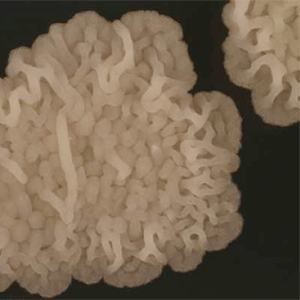Contact
Tomas.Linder@slu.se, 018-673210

The word “yeast” describes diverse groups of fungi that spend all or at least part of their life cycle as single cells. The yeast most familiar to many of us is the species Saccharomyces cerevisiae, more commonly known as baker’s yeast or brewer’s yeast.
In addition to its central role in brewing and baking, S. cerevisiae has also become one of the most intensely studied organisms at the cellular level because of the ease at which it can be genetically manipulated. Molecular studies of S. cerevisiae have helped us understand how fundamental processes work in our own cells.
S. cerevisiae belongs to a larger taxonomic group of predominantly single-celled fungi commonly known as “budding yeasts”. This group – the sub-phylum Saccharomycotina, also contains the common opportunistic pathogen Candida albicans as well as the wine and beer spoilage yeast Brettanomyces bruxellensis. Unlike S. cerevisiae, these other budding yeasts (more than 1000 species described so far) are not as well understood at the cellular level and are often referred to as “non-conventional yeasts” for this reason.
This research project focuses on metabolic pathways in non-conventional yeasts that do not occur in S. cerevisiae. A metabolic pathway is essentially either an assembly or disassembly line for chemical compounds that the yeast cell either needs to build or break down.
The intricate cellular structures found within a yeast cell – outer and inner membranes, the outer cell wall, the DNA chains making up the yeast chromosomes etc., can be (and often are) built from very simple substrates. In order to be able to grow and divide, a yeast cell must have access to external sources of carbon, nitrogen, sulfur and phosphorous as well as micronutrients such as salts and dissolved metal ions.
Sometimes a yeast cell might be lucky and find remnants of other cells that it can easily recycle for its own use. But more often, a yeast cell has to make do with whatever sources of carbon, nitrogen, sulfur and phosphorous that happen to be nearby.
The ability of a particular species of yeast to either make a particular chemical compound or break it down depends on whether it possesses to requisite metabolic pathway to do so. A better understanding of the metabolic properties of non-conventional yeasts can lead to new applications. For example, a number of non-conventional yeasts can break down man-made chemicals such as pesticides, detergents, solvents, dyes and pharmaceuticals that may otherwise cause harm to the environment.
Some non-conventional yeasts can produce fuel ethanol or diesel-like oils from sugars extracted from wood. By understanding what genes are involved in these metabolic pathways and how they are regulated, it will be possible to improve pathway performance and efficiency using genetic methods. As of November 2018, some 350 species of budding yeasts have had their genomes completely sequenced yet, with the exception of S. cerevisiae and C. albicans, the functional annotation of these genomes is virtually absent.
A better understanding of yeast metabolism can provide insights into the ecological roles that yeasts play in nature. Many budding yeasts are associated with insects and yeast metabolism may play a role in helping insects digest their food, provide them with essential nutrients and help neutralize toxins in their diet. In return, insects are thought to help budding yeasts colonize new environments such as the nectar of a flower, sap oozing from a tree, a decaying fruit or the surface of a leaf.
Simply put, understanding the metabolic network of a yeast cell is the key to understanding its biology.
Tomas.Linder@slu.se, 018-673210
Linder T. (2018) A genomic survey of nitrogen assimilation pathways in budding yeasts (sub-phylum Saccharomycotina). Yeast. In press. (Link[TL1] )
Linder T. (2018) Assimilation of alternative sulfur sources in fungi. World Journal of Microbiology and Biotechnology. 34: 51. (Link[TL2] )
Linder T. (2018) Genetic redundancy in the catabolism of methylated amines in the yeast Scheffersomyces stipitis. Antonie Van Leeuwenhoek. 111: 401-411. (Link[TL3] )
Linder T. (2017) ATP sulfurylase is essential for the utilisation of sulfamate as a sulfur source in the yeast Komagataella pastoris (syn. Pichia pastoris). Current Microbiology. 74: 1021-1025. (Link[TL4] )
Piper AM, Farnier K, Linder T, Speight R, Cunningham JP. (2017) Two gut-associated yeasts in a tephritid fruit fly have contrasting effects on adult attraction and larval survival. Journal of Chemical Ecology. 43: 891-901. (A popular science summary)
Linder T. (2016) Utilisation of aromatic organosulfur compounds as sulfur sources by Lipomyces starkeyi CBS 1807. Antonie Van Leeuwenhoek. 109: 1417-1422. (Link[TL7] )
Linder T. (2014) CMO1 encodes a putative choline monooxygenase and is required for the utilization of choline as the sole nitrogen source in the yeast Scheffersomyces stipitis (syn. Pichia stipitis). Microbiology. 160: 929-940. (Link[TL8] )
Linder T. (2012) Genomics of alternative sulfur utilization in ascomycetous yeasts. Microbiology. 158: 2585-2597.